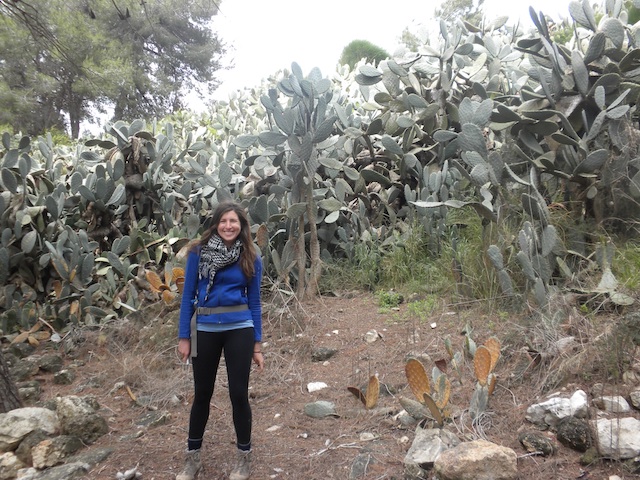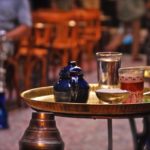Zippori: Time Preserved in Tiles

Trekking from Nazareth on the first leg of the “Jesus Trail,” I ascend to Zippori National Park, which sits atop a mountain 289 m above sea. The site houses archeological ruins from an ancient Jewish city whose history is much like Israel’s itself; Zippori has experienced a multitude of changes, with civilizations ousting one another in turbulent sequence. Being up here is like touching the past.
I could spend hours taking in the magnificent panoramic view of the Zippori valley. It is this birds-eye view to which the site’s name is attributed (zippori means bird in Hebrew). But the main attractions at Zippori are the mosaics, which remained intact for centuries and have now been refurbished.
I wander to the Nile House, once a municipal building whose floors were completely adorned with mosaics. Some curiously modern amenities were also discovered here, including an ancient water storage system and a primitive toilet.
Zippori: Time Preserved in Tiles.
The mosaics at the Nile House are breathtaking: exquisite tessellations frame the floors of each room, along with images of mythical animals. A centaur, which holds the words “Helpful God” in Greek catches my eye.
Most remarkable of these mosaics is one that covers the floor of an entire room depicting an elaborate celebration of the flood of the Nile. This mosaic is both a gracious ode to the abundance provided by water as well as a celebration of man’s strength. There’s a strong element of gratitude here too: the mosaic seems to be thanking powers divine for water’s gifts to man, and also for the human ability to extract bounty from the elements of nature.
My mind wonders to the land below us where Wadi Zippori, the stream named for this city, waters the valley as it has for millions of years. Today complex irrigation systems, whose pipes are visible from Zippori, make the valley lush-green. Instead of a mosaic this technology is our celebration of water, or rather our seeming mastery of it.
After ample time at the Nile house I continue on the loop of the park.
After ample time at the Nile house I continue on the loop of the park. I stroll through a dense cactus garden and emerge at the Fortress.
The Fortress, which was originally used by Arabs to fend off Christian crusaders, is now a museum that holds artifacts excavated from the site. There’s detailed information about Jewish, Roman, Arab, and Christian life at Zippori. It’s also the best view of the valley — Jewish and Arab villages sit scattered below.
I learn about the different eras of Zippori’s history; as a hub of Jewish life in the Galilee, as a Roman and later Byzantine militarily strategic point, as the home of Anne and Joachim, Mary Magdalene’s parents, and as Saffuriyyeh, the Arab village that was here prior to the War of Israeli Independence.
As I try to suss out this inundation of facts and dates one question keeps running through my mind: If history is told by the winners, whose story is Zippori telling? Zippori’s story seems too disjointed to belong to anybody. I leave the fortress baffled.
I duck into the Dionysus house, the main attraction at Zippori. At the center of the mosaic, which contained over a million tiles when it was constructed, are scenes depicting the drinking competition between Hercules and Dionysus, with Dionysus as the hands-down winner. Compared to the boastfulness of human strength and dexterity at the Nile house, this mosaic expresses humility. It reminds us that we’re only human, unable to go beyond the limits of our mere mortality.
I emerge from the Dionysus house and make my way my back into the present.
Surrounding these scenes is a mosaic perimeter which, despite being patchy, holds preserved the face of a beautiful woman, whose enigmatic gaze has made her, and the site itself, famous. Known as “the Mona Lisa of Zippori”, the expression on her ethereal, full face seems to taunt. Her eyes are sardonic, a mocking smirk sits on her lips.
It’s a miracle that she’s still here. I start to wonder if maybe if she’s the winner, if Zippori’s story belongs to her. After the city’s inhabitants vanished into the abyss of time, after multiple civilizations have risen and collapsed, and the buildings themselves have crumbled, she’s remained. All of the glory of our own civilization, our technology, will eventually decay, but what will last? At Zippori it is the mosaics that have stood the test of time.
I emerge from the Dionysus house and make my way my back into the present. The day is bright and cloudy and not too hot, perfect for the trek back to Nazareth. It’s as if a divine power – “helpful god” – has orchestrated the elements just so. I put one boot in front of the other and make my way down the mountain.
Photo by Larissa Shulman.








